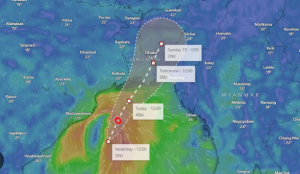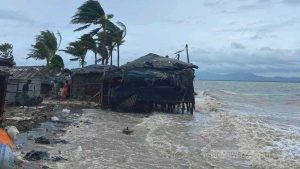The Deep Depression’s Impact on Bangladesh’s Coastal Regions

On May 29, 2025, a deep depression over the Bay of Bengal began crossing the coastal areas of Bangladesh, bringing with it heavy rains, gusty winds, and the threat of tidal surges. The Bangladesh Meteorological Department issued local cautionary signal number 3 for maritime ports, including Chattogram, Cox’s Bazar, Mongla, and Payra, advising all fishing boats and trawlers in the North Bay to remain in safe shelters until further notice.
Karnaphuli River and Patenga: The Heartbeat of Chattogram
The Karnaphuli River, a vital waterway for Chattogram, faced increased water levels due to the depression. While the Kaptai Dam authorities planned a controlled release of water, they assured minimal impact on the river’s water levels. However, the situation remains precarious, especially in areas like Patenga, where the river meets the sea.

Patenga, a coastal area in Chattogram, experienced rough seas and high waves, leading to concerns about erosion and damage to infrastructure. The local administration remained vigilant, monitoring the situation closely to prevent any untoward incidents.
Cox’s Bazar and Teknaf: Battling the Elements
Cox’s Bazar, renowned for its long sandy beach, faced the brunt of the depression with very windy conditions and heavy rainfall. The sea remained rough, and authorities advised caution to prevent accidents.
In Teknaf, the southernmost point of mainland Bangladesh, the situation was equally dire. The area recorded the maximum rainfall in the country, with 61mm on Wednesday. The heavy rains led to concerns about flooding and landslides, prompting local authorities to remain on high alert.
Mongla, Shibsha, Pasur, and Rupsha Rivers: The Southern Front
In the southern coastal regions, rivers like Mongla, Shibsha, Pasur, and Rupsha faced swelling water levels due to the depression. The Pasur River, in particular, saw fishing boats anchored along its banks as a precautionary measure.

The Rupsha River, near Mongla, also experienced increased water levels, raising concerns about potential flooding in nearby areas. Local communities, dependent on these rivers for their livelihoods, braced for the impact, with many securing their homes and belongings.
Disruption to Daily Life and Livelihoods
The deep depression significantly disrupted daily life in the affected regions. Fishing activities came to a halt, impacting the primary source of income for many coastal communities. Transportation was affected, with roads becoming impassable due to waterlogging and fallen trees.
In urban areas, power outages were reported, and schools remained closed as a precautionary measure. The continuous rainfall and strong winds made it challenging for residents to carry out their daily activities, leading to economic losses and increased hardship.

Conclusion
The deep depression over the Bay of Bengal serves as a stark reminder of Bangladesh’s coastal regions’ vulnerability to natural disasters. While immediate measures are crucial to mitigate the impact, long-term strategies focusing on infrastructure resilience, early warning systems, and community preparedness are essential to safeguard lives and livelihoods in the face of such climatic events.






















